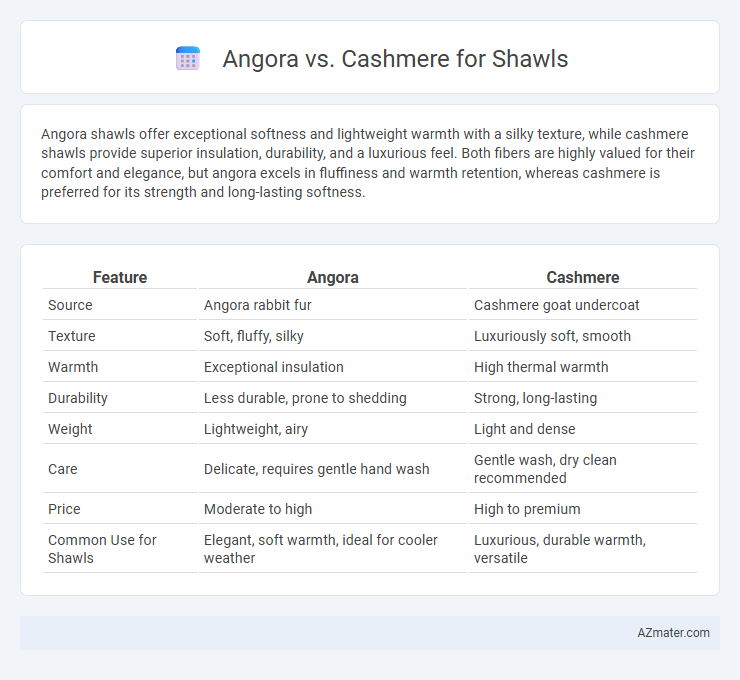Angora shawls offer exceptional softness and lightweight warmth with a silky texture, while cashmere shawls provide superior insulation, durability, and a luxurious feel. Both fibers are highly valued for their comfort and elegance, but angora excels in fluffiness and warmth retention, whereas cashmere is preferred for its strength and long-lasting softness.
Table of Comparison
| Feature | Angora | Cashmere |
|---|---|---|
| Source | Angora rabbit fur | Cashmere goat undercoat |
| Texture | Soft, fluffy, silky | Luxuriously soft, smooth |
| Warmth | Exceptional insulation | High thermal warmth |
| Durability | Less durable, prone to shedding | Strong, long-lasting |
| Weight | Lightweight, airy | Light and dense |
| Care | Delicate, requires gentle hand wash | Gentle wash, dry clean recommended |
| Price | Moderate to high | High to premium |
| Common Use for Shawls | Elegant, soft warmth, ideal for cooler weather | Luxurious, durable warmth, versatile |
Introduction: Angora vs Cashmere Shawls
Angora shawls, crafted from the silky fur of Angora rabbits, offer exceptional warmth and a lightweight feel, making them ideal for delicate, luxurious wraps. Cashmere shawls, derived from the undercoat of Cashmere goats, are renowned for their superior softness, durability, and insulating properties, often commanding higher prices due to their scarcity. Both fibers excel in comfort and elegance, but Angora provides a fluffier texture while Cashmere delivers a smoother, more resilient finish.
Fiber Origins: Where Angora and Cashmere Come From
Angora fibers originate from the Angora rabbit, primarily farmed in regions such as China, France, and Turkey, known for their silky, fine texture that enhances softness and warmth in shawls. Cashmere comes from the undercoat of Cashmere goats found mainly in Mongolia, China, and India, prized for its exceptional insulating properties and lightweight feel. Both fibers are harvested through careful combing or shearing, ensuring sustainable fiber collection that preserves animal welfare.
Texture and Softness Comparison
Angora shawls offer a luxurious texture characterized by a silky and fluffy feel, derived from the soft undercoat of Angora rabbits, making them exceptionally warm and lightweight. Cashmere shawls, obtained from the fine undercoat of cashmere goats, provide unparalleled softness with a smooth yet slightly denser texture that retains heat effectively without bulk. Comparing texture and softness, Angora is more delicate and airy with a wispy halo effect, while cashmere delivers a richer, plush softness that drapes elegantly on the skin.
Warmth and Insulation Properties
Angora fibers, derived from Angora rabbits, offer exceptional warmth due to their hollow core, which provides superior insulation by trapping heat effectively. Cashmere, sourced from the undercoat of Cashmere goats, is renowned for its fine, soft texture and excellent thermal regulation, balancing warmth with breathability. When comparing shawls, Angora tends to provide a higher insulation level ideal for colder climates, while Cashmere delivers warmth with lightweight comfort suitable for versatile weather conditions.
Durability and Longevity
Angora fibers, sourced from Angora rabbits, are known for their silky texture but tend to be less durable and prone to shedding compared to cashmere. Cashmere, derived from the undercoat of Cashmere goats, offers superior longevity due to its stronger fibers and resilience against wear and tear. For shawls requiring extended durability, cashmere provides better long-term performance while maintaining softness and warmth.
Breathability and Comfort
Angora fibers are known for exceptional softness and warmth, offering superior insulation while maintaining breathability suitable for shawls. Cashmere provides a luxurious, lightweight feel with excellent thermal regulation, allowing for comfortable wear in various temperatures. Both fibers excel in comfort, but Angora's loftier texture enhances warmth, whereas Cashmere's fine fibers optimize airflow and moisture wicking.
Hypoallergenic Qualities
Cashmere shawls are generally more hypoallergenic compared to Angora, as cashmere fibers come from goats and tend to cause fewer allergic reactions. Angora fibers, sourced from rabbits, contain lanolin and other proteins that can trigger sensitivities in people with wool allergies. For individuals with sensitive skin, cashmere offers a softer and less irritating option, making it ideal for shawls worn close to the skin.
Care and Maintenance Requirements
Angora shawls require gentle hand washing with cool water and mild detergent to prevent fiber damage and maintain softness, along with careful drying flat to avoid stretching. Cashmere shawls demand delicate handling, including periodic dry cleaning or hand washing with specialized cashmere shampoo, followed by reshaping and flat drying to preserve the fine fibers. Proper storage in breathable bags away from direct sunlight protects both Angora and Cashmere shawls from moth damage and fiber deterioration.
Eco-Friendliness and Ethical Considerations
Angora wool, sourced from Angora rabbits, raises ethical concerns due to animal welfare issues and often involves intensive farming practices, whereas cashmere, derived from goats, can be more sustainable when harvested via responsible combing methods that avoid harming the animals. Eco-friendly cashmere production emphasizes regenerative grazing and water-efficient processing, reducing environmental impact compared to traditional Angora farming that may contribute to habitat degradation. Choosing certified sustainable cashmere brands supports ethical labor conditions and biodiversity, offering a more responsible option for eco-conscious shawl consumers.
Price and Value Comparison
Angora shawls typically cost more than cashmere due to the rarity and delicate harvesting process of Angora fibers, which come from Angora rabbits and offer exceptional softness and warmth. Cashmere shawls, sourced from the undercoat of cashmere goats, generally provide a balanced price-to-value ratio with widespread availability and durability. For buyers prioritizing luxury and exclusivity, Angora offers higher perceived value, while cashmere is favored for everyday elegance combined with affordability.

Infographic: Angora vs Cashmere for Shawl
 azmater.com
azmater.com